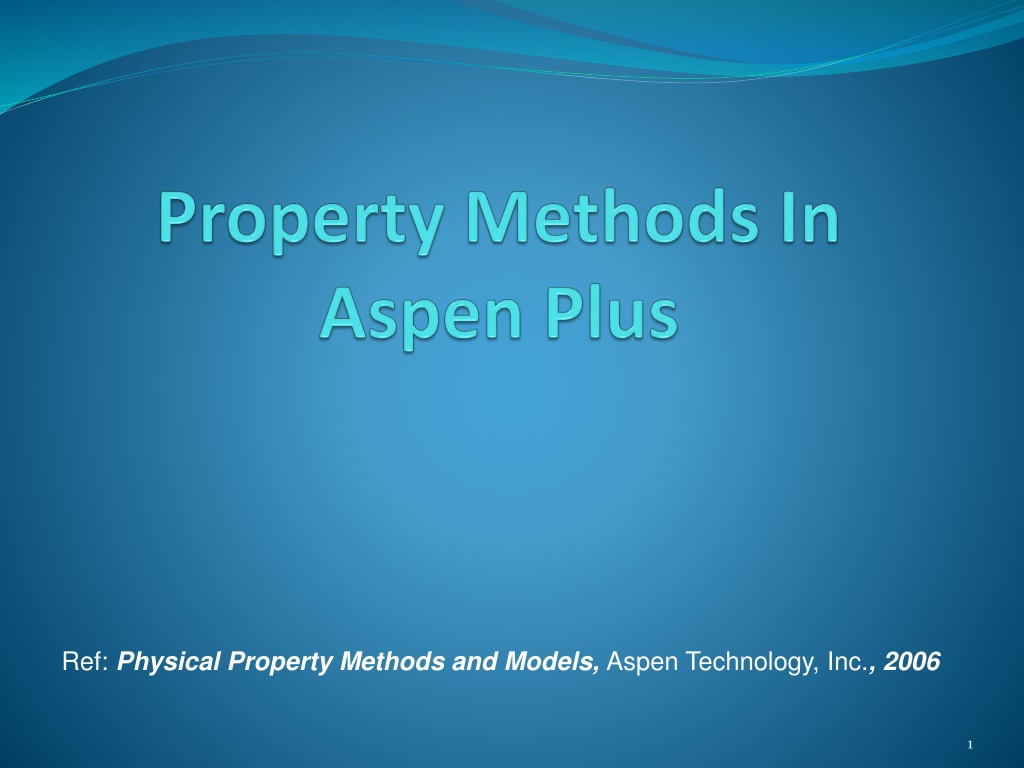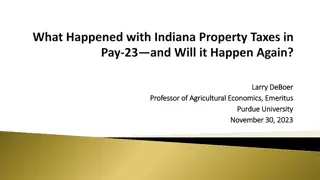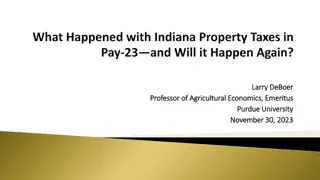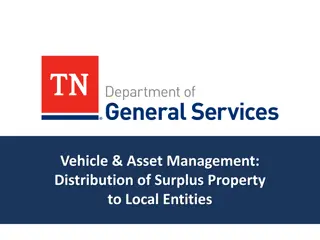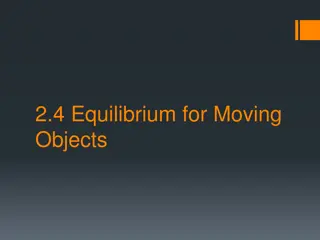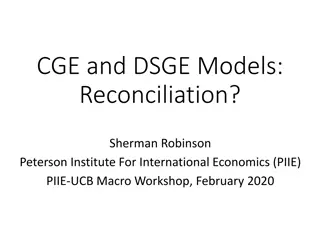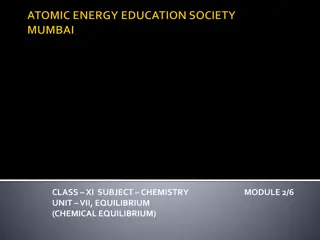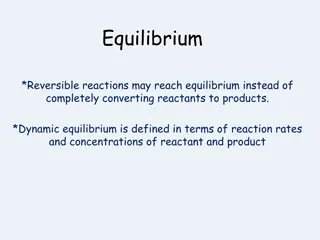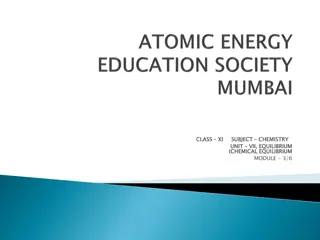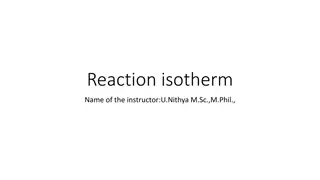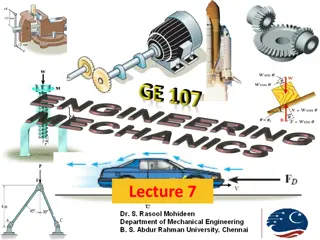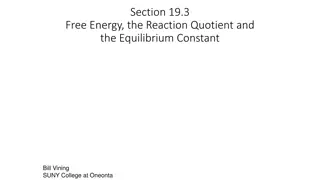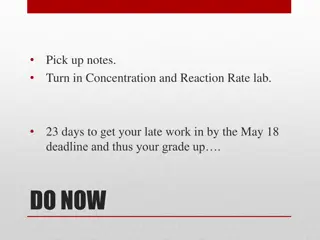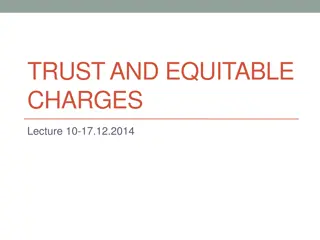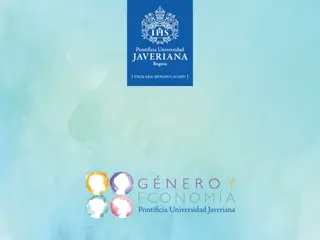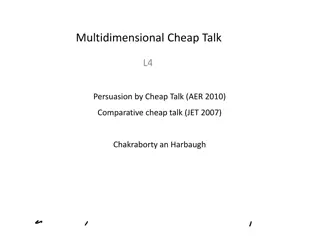Property Methods and Equilibrium Models
This content delves into various property methods and equilibrium models essential for accurate property calculations. Explore thermodynamic properties, transport properties, and different classes of property methods available. Dive into the details of EOS methods for vapor-liquid equilibrium and fugacity coefficient formulas in the Aspen Physical Property System.
Download Presentation

Please find below an Image/Link to download the presentation.
The content on the website is provided AS IS for your information and personal use only. It may not be sold, licensed, or shared on other websites without obtaining consent from the author.If you encounter any issues during the download, it is possible that the publisher has removed the file from their server.
You are allowed to download the files provided on this website for personal or commercial use, subject to the condition that they are used lawfully. All files are the property of their respective owners.
The content on the website is provided AS IS for your information and personal use only. It may not be sold, licensed, or shared on other websites without obtaining consent from the author.
E N D
Presentation Transcript
Ref: Physical Property Methods and Models, Aspen Technology, Inc., 2006 1
Property Methods A property method is a collection of property calculation routes. Thermodynamic properties: Phase equilibrium (VLE, LLE, VLLE) Enthalpy Entropy Gibbs free energy Molar volume Transport properties: Viscosity Thermal conductivity Diffusion coefficient Surface tension 2
Property Methods It is important to choose the right property method for an application to ensure the success of your calculation. The classes of property methods available are: IDEAL Liquid fugacity and K-value correlations Petroleum tuned equations of state Equations of state for high pressure hydrocarbon applications Flexible and predictive equations of state Liquid activity coefficients Electrolyte activity coefficients and correlations Solids processing Steam tables 3
EOS Method 1-Vapor-Liquid Equilibrium f = v l f At Equilibrium: i i = = v v i l l , f y P f x P Where i i t i i i t l y = = vl i i i k Therefore v i x i 4
EOS Method 2-Fugacity Coefficient Formula 1 P RT V i m = ln ln dV Z RT n V i V , , T n j Cubic Equations of State in the Aspen Physical Property System Redlich-Kwong(-Soave) based Redlich-Kwong (RK) Standard Redlich-Kwong-Soave(RK-SOAVE ) Redlich-Kwong-Soave (RKS-BM) Redlich-Kwong-ASPEN(RK-ASPEN) Schwartzentruber-Renon Redlich-Kwong-Soave-MHV2 Predictive SRK (PSRK) Redlich-Kwong-Soave-WS Peng-Robinson based Standard Peng-Robinson(PENG-ROB) Peng-Robinson(PR-BM) Peng-Robinson-MHV2 Peng-Robinson-WS 5
EOS Method 3-Standard RK-SOAVE RT P m a = + ( ) V b V V b m m Where i i = = 5 . 0 ( ) 1 ( , ) a x x a a k b x b i j i j ij i i j 2 2 R T RT 42747 . 0 = = , 08664 . 0 ci ci a b i i i P P ci ci = + = . 1 + 5 . 0 ri 2 2 i ( ) 1 [ 1 ( i )] , . 0 48 57 . 0 176 T m T m i i i 6
EOS Method 4-Standard PENG-ROB RT P m m a = + + ( ) ( ) V b V V b b V b m m Where i i = = 5 . 0 ( ) 1 ( , ) a x x a a k b x b i j i j ij i i j 2 2 R T RT 45724 . 0 = = , 07780 . 0 ci ci a b i i i P P ci ci = + = 54226 . 1 + 26992 . 0 5 . 0 ri 2 2 i ( ) 1 [ 1 ( i )] , 37464 . 0 T m T m i i i 7
EOS Method 5-Advantages and Disadvantages Equations of state can be used over wide ranges of temperature and pressure, including subcritical and supercritical regions. Thermodynamic properties for both the vapor and liquid phases can be computed with a minimum amount of component data. For the best representation of non-ideal systems, you must obtain binary interaction parameters from regression of experimental VLE data. Binary parameters for many component pairs are available in the Aspen databanks. 8
EOS Method 5-Advantages and Disadvantages Equations of state are suitable for modeling hydrocarbon systems with light gases such as CO2 , N2 and H2 S. The assumptions in the simpler equations of state (SRK, PR, Lee-Kesler , ) are not capable of representing highly non-ideal chemical systems, such as alcohol-water systems. Use the activity-coefficient options sets for these systems at low pressures. At high pressures, use the predictive equations of state. 9
EOS Method 6-Enthalpy calculation Vapor Enthalpy: Liquid Enthalpy: Standard enthalpy of formation for ideal gas at 298.15 K and 1 atm Where: 10
Activity Coefficient Method 1- Vapor-Liquid Equilibrium f = v l f At Equilibrium: Where Therefore i i = = *, v v i l l , f y P f x f i i t i i i i *, l y f = = vl i i i i k v i x P i t F0r ideal gas and liquid , 1 = * y P = = = v i vl i 1 ' i i k Raoult s Law i x P i t 11
Activity Coefficient Method 2- Liquid-Liquid Equilibrium = l l f f 1 2 At Equilibrium: i i = = l l i l i l l i l i *, *, l l , f x f f x f 1 1 1 2 2 2 Where i i i i l i l i x 1 2 = = l l i k Therefore 1 2 l i l i x 2 1 12
Activity Coefficient Method 3- Vapor-Liquid-Liquid Equilibrium = = l l v f f f 1 2 At Equilibrium: i i i = = l l i l i l l i l i *, *, l l , f x f f x f 1 1 1 2 2 2 Where i i i i = v v i f y P i i t Therefore l i l i *, *, l l y f y f 1 2 = = = = vl i vl i , i i i i k k 1 2 l i l i v i v i x P x P 1 2 t t 13
Activity Coefficient Method 4- Liquid Phase Reference Fugacity For solvents: The reference state for a solvent is defined as pure component in the liquid state, at the temperature and pressure of the system. = l *, *, i *, *, *, i l v l l ( , ) , ( 1 ) 1 f T P P as x i i i i i i*,v= Fugacity coefficient of pure component i at the system temperature and vapor pressures, as calculated from the vapor phase equation of state 1 P i*,l= Poynting factor = *, *, l l exp V dP i i RT *, l P i 14
Activity Coefficient Method 4- Liquid Phase Reference Fugacity For dissolved gases: Light gases (such as O2 and N2 ) are usually supercritical at the temperature and pressure of the solution. In that case pure component vapor pressure is meaningless and therefore it cannot serve as the reference fugacity. = * i * i l 1 0 f x H and as x i i i i Using an Empirical Correlation: The reference state fugacity is calculated using an empirical correlation. Examples are the Chao-Seader or the Grayson-Streed model. 15
Activity Coefficient Method 5- Multicomponent Mixtures Multicomponent vapor-liquid equilibria are calculated from binary parameters. These parameters are usually fitted to binary phase equilibrium data (and not multicomponent data) and represent therefore binary information. The prediction of multicomponent phase behavior from binary information is generally good. Multi-component liquid-liquid equilibria cannot be reliably predicted from binary interaction parameters fitted to binary data only. In general, regression of binary parameters from multi-component data will be necessary. 16
Activity Coefficient Method 6- NRTL (Non-Random Two-Liquid) The NRTL model calculates liquid activity coefficients for the following property methods: NRTL, NRTL-2, NRTL-HOC, NRTL-NTH, and NRTL-RK. It is recommended for highly nonideal chemical systems, and can be used for VLE, LLE and VLLE applications. j m j x G x G ji ji x G m mj mj j j x ij G = + ln k k k i ij x G x G k ki k kj k kj 17
Activity Coefficient Method 6- NRTL (Non-Random Two-Liquid) j m j x G x G ji ji x G m mj mj j j x ij G = + ln k k k i ij x G x G k ki k kj k kj Where = = exp( ) , 1 G G ij ij ij ii = + + + = ln , 0 a b T e T f T ij ij ij ij ij ii = + ( 273 . 15 ) c d T ij ij ij The binary parameters aij, bij, cij, dij, eijand fijcan be determined from VLE and/or LLE data regression. The Aspen Physical Property System has a large number of built-in binary parameters for the NRTL model. 18
Activity Coefficient Method 7- Advantages and Disadvantages The activity coefficient method is the best way to represent highly non-ideal liquid mixtures at low pressures. You must estimate or obtain binary parameters from experimental data, such as phase equilibrium data. Binary parameters are valid only over the temperature and pressure ranges of the data. The activity coefficient approach should be used only at low pressures (below 10 atm). The Wilson model cannot describe liquid-liquid separation at all; UNIQUAC, UNIFAC and NRTL are suitable. 19
Activity Coefficient Method 8- Enthalpy calculation Vapor Enthalpy: Vapor enthalpy are computed from the EOS that selected for vapor phase (The same as EOS method). Liquid Enthalpy: 20
Principle Steps in Selecting the Appropriate Property Method 1. Choosing the most suitable property method. 2. Comparing the obtained predictions with data from the literature. 3. Estimate or obtain binary parameters from experimental data if necessary. 4. Generation of lab data if necessary to check the property model. 21
Eric Carlsons Recommendations Non-electrolyte Figure 1 See Figure 2 See Figure 2 Polar E? Electrolyte NRTL Or Pizer Electrolyte Real Peng-Robinson, Redlich-Kwong-Soave, Lee-Kesler-Plocker All Non-polar R? Chao-Seader, Grayson-Streed or Braun K-10 Polarity Real or pseudocomponents Pseudo & Real R? P? Pressure P? Vacuum Braun K-10 or ideal E? Electrolytes 22
Yes NRTL, UNIQUAC and their variances Figure 2 Yes LL? WILSON, NRTL, UNIQUAC and their variances P < 10 bar No ij? (See also Figure 3) (See also Figure 3) Yes UNIFAC LLE No P? LL? Polar Non-electrolytes No UNIFAC and its extensions Schwartentruber-Renon PR or SRK with WS PR or SRK with MHV2 Yes LL? Liquid/Liquid Pressure P > 10 bar P? ij? PSRK PR or SRK with MHV2 No ij? Interaction Parameters Available 23
Wilson, NRTL, UNIQUAC, or UNIFAC with special EOS for Hexamers Hexamers Figure 3 Yes DP? Wilson, NRTL, UNIQUAC, UNIFAC with Hayden O Connell or Northnagel EOS Dimers VAP? Wilson NRTL UNIQUAC UNIFAC Wilson, NRTL, UNIQUAC, or UNIFAC* with ideal Gas or RK EOS No Vapor Phase Association VAP? UNIFAC* and its Extensions Degrees of Polymerizatiom DP? 24
Eric Carlsons Recommendations for 1-Propanol ,H2O mixture Figure 1 Non-electrolyte See Figure 2 See Figure 2 Polar E? Polarity Real or pseudocomponents R? Pressure P? E? Electrolytes 25
Figure 2 Yes LL? WILSON, NRTL, UNIQUAC and their variances P < 10 bar No ij? (See also Figure 3) (See also Figure 3) No P? LL? Polar Non-electrolytes No UNIFAC and its extensions LL? Liquid/Liquid Pressure P? ij? Interaction Parameters Available 26
